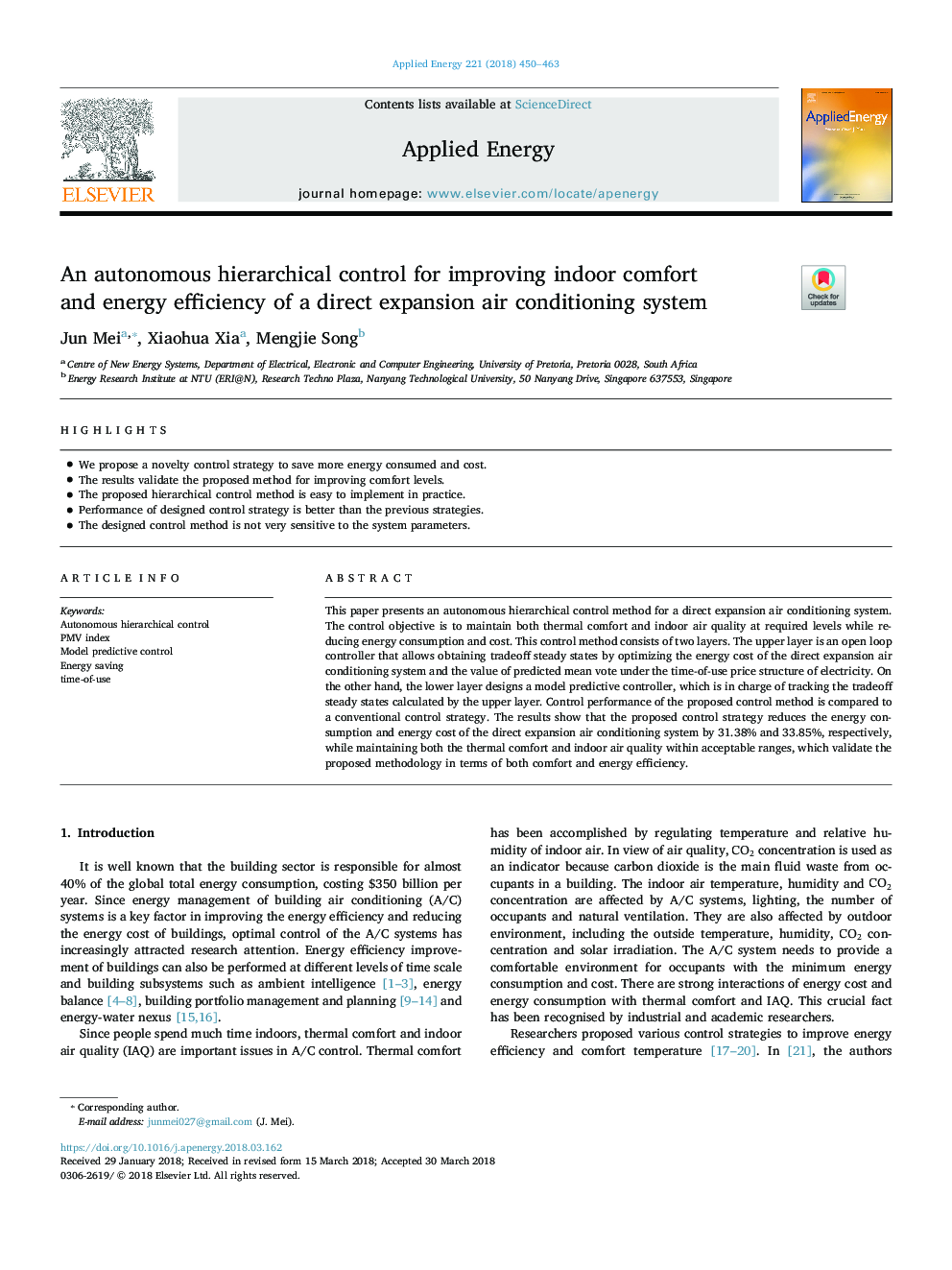| کد مقاله | کد نشریه | سال انتشار | مقاله انگلیسی | نسخه تمام متن |
|---|---|---|---|---|
| 6680150 | 1428069 | 2018 | 14 صفحه PDF | دانلود رایگان |
عنوان انگلیسی مقاله ISI
An autonomous hierarchical control for improving indoor comfort and energy efficiency of a direct expansion air conditioning system
ترجمه فارسی عنوان
یک کنترل سلسله مراتبی مستقل برای بهبود راحتی در محیط و بهره وری انرژی یک سیستم تهویه مطبوع گسترش مستقیم
دانلود مقاله + سفارش ترجمه
دانلود مقاله ISI انگلیسی
رایگان برای ایرانیان
کلمات کلیدی
ترجمه چکیده
این مقاله روش کنترل سلسله مراتبی خودمختار را برای یک سیستم تهویه مطبوع گسترش مستقیم ارائه می دهد. هدف کنترل حفظ راحتی حرارتی و کیفیت هوای داخل ساختمان در سطوح مورد نیاز است، در حالی که کاهش مصرف انرژی و هزینه. این روش کنترل شامل دو لایه است. لایه فوقانی یک کنترل کننده حلقه باز است که با بهینه سازی هزینه انرژی سیستم تهویه مطبوع و ارزش رایانه پیش بینی شده تحت ساختار قیمت مصرف انرژی الکتریسیته می تواند وضعیت های پایدار را به دست آورد. از سوی دیگر، لایه پایین تر، یک کنترل کننده پیش بینی مدل را طراحی می کند که مسئول ردیابی حالت های پایدار تجاری است که توسط لایه بالایی محاسبه می شود. عملکرد کنترل روش پیشنهادی کنترل با یک استراتژی کنترل معمولی مقایسه شده است. نتایج نشان می دهد که استراتژی کنترل پیشنهادی هزینه های انرژی و هزینه های سیستم تهویه مطبوع گسترش مستقیم را به ترتیب 31.38٪ و 33.85٪ کاهش می دهد، در حالی که حفظ راحتی حرارتی و کیفیت هوا در داخل محدوده های قابل قبول، که اعتبار روش پیشنهادی از لحاظ راحتی و بهره وری انرژی.
موضوعات مرتبط
مهندسی و علوم پایه
مهندسی انرژی
مهندسی انرژی و فناوری های برق
چکیده انگلیسی
This paper presents an autonomous hierarchical control method for a direct expansion air conditioning system. The control objective is to maintain both thermal comfort and indoor air quality at required levels while reducing energy consumption and cost. This control method consists of two layers. The upper layer is an open loop controller that allows obtaining tradeoff steady states by optimizing the energy cost of the direct expansion air conditioning system and the value of predicted mean vote under the time-of-use price structure of electricity. On the other hand, the lower layer designs a model predictive controller, which is in charge of tracking the tradeoff steady states calculated by the upper layer. Control performance of the proposed control method is compared to a conventional control strategy. The results show that the proposed control strategy reduces the energy consumption and energy cost of the direct expansion air conditioning system by 31.38% and 33.85%, respectively, while maintaining both the thermal comfort and indoor air quality within acceptable ranges, which validate the proposed methodology in terms of both comfort and energy efficiency.
ناشر
Database: Elsevier - ScienceDirect (ساینس دایرکت)
Journal: Applied Energy - Volume 221, 1 July 2018, Pages 450-463
Journal: Applied Energy - Volume 221, 1 July 2018, Pages 450-463
نویسندگان
Jun Mei, Xiaohua Xia, Mengjie Song,
